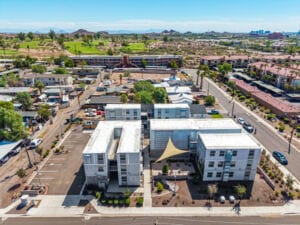When the final tally is concluded and the numbers checked and double-checked, the surprising result will show an almost record year for Phoenix-metro home purchases in 2009. That should produce a sigh of relief to the many who sense the Valley’s residential market has hit bottom and it’s time to look ahead to recovery.
Not so fast, interject the naysayers. There are so many problems that still need to be overcome, the local housing market could end up bouncing along the bottom of the cycle for years, if not suffer a secondary bout of recession.
The sticking points deflating the recovery bubble are numerous: more Americans falling behind on mortgage payments, intractable unemployment, a shadow inventory of homes and another wave of exotic adjustable-rate mortgages coming due over the next two years. All that could overwhelm the strong gains seen in the housing market in 2009.
The residential housing resale market in Phoenix has experienced a substantial uptick, reports RL Brown, who publishes the RL Brown Housing Reports. In October 2009, resales totaled 8,167 units as compared to 5,697 units for the same month the year before — a 43 percent increase in resale activity.
“At 8,000 homes a month, that comes wonderfully close to the important 100,000-unit-a-year market, which the Phoenix market first crossed back in 2004, when 112,000 units were sold,” Brown says. “That number took a surprisingly long time to attain, with resales at 75,000 in 2002 and 87,000 in 2003, and then just as difficult to maintain. In 2006, resales fell to 90,000 units and by 2007 hit 58,000 units.
“We are selling inventory above historical levels,” Brown avers. “That’s a demonstration of recovery.”
However, Jay Butler, an associate professor of real estate at Arizona State University, unearths some underlying problems in all that activity, in particular the fact that the resale of foreclosed properties, which had been running at about 60 percent of the resales, is what’s boosting the market.
In that hot-hot-hot October 2009, 30 percent of the recorded sales activity was foreclosures and another 30 percent to 35 percent was due to investors or lenders selling REO (bank-owned real estate) property back into the marketplace, which indicates that more than 60 percent of the resales were due to failed mortgages. When asked what the historical level of resales due to foreclosure activity was, Butler answered 3 percent to 5 percent.
The Buyers
Still, with all those homes being bought, whether they were foreclosed upon, new or simply the result of a straightforward transaction between a healthy seller and healthy buyer, the important point is the inventory of homes for sale was heading in the right direction in October.
“Unfortunately, there’s a negative interpretation to that phenomenon as well. Probably a third of all resale units being purchased are by investors,” explains Elliot Pollack, founder of the economic consulting firm Elliott D. Pollack & Co. “And investors tend to purchase homes they can fix up and resell. In fact, about 50 percent of all fix-up homes are bought by investors as compared to 25 percent of all move-in homes. Many of those homes bought by investors will come back into the marketplace.”
The other large group that has been buying up single-family properties has been the first-time homebuyers lured into the market by affordability, low interest rates and the Obama administration’s $8,000 tax credit. The target of this demographic group, in a sense, is not much different from the investor hordes — cheap homes. Since inventory in this category has been whittled down, that leaves an inventory of more expensive properties.
With the lower tier of homes moving to new buyers and investors, in a normal market this trend line would eventually result in average home prices increasing as home purchasers start moving up to bigger, more expensive homes. The trouble is, the Phoenix residential market remains wildly out of sync.
Earlier in 2009, Pollack predicted the Valley would end the year with an extraordinary number of vacant properties, perhaps totaling 50,000. By November, Pollack was quickly re-tabulating, and now expects 80,000 vacant properties, or about 9.8 percent of the market. Historically, vacant homes only made up 2.3 percent of the market.
“This is a big, continuing supply of properties,” Pollack says.
“Phoenix is still a long way from getting back to a market that is structurally normal.” – Jay Butler, Arizona State University
Bad Options
That number could get even bigger in 2010 due to resets on adjustable-rate mortgages.
Earlier in the last decade, during the heyday of exotic mortgages, one of the more popular loans was the Option-ARM, which initially offered the borrower four monthly payment options all with low teaser rates that would eventually reset. The borrower generally made payments less than the accruing interest, which resulted in negative amortization, or the unpaid portion of the interest added to the principal balance.
Most of these loans were written in 2005 and 2006, with five-year resets. Starting this year and going into next year, these mortgages will reset with higher rates and at a range unaffordable to most holders of Option-ARMs.
Securitzed Option-ARMS (about 70 percent of all Option-ARMs are securitized) total $189 billion, and of that $134 billion will be recast in 2010 and 2011, reports Alla Sirotic a senior managing director at Fitch Ratings.
“This is a product that will see one of the highest default rates,” she adds.
And Butler maintains: “This will be another subprime-type trampling of the mortgage market. Some people say this is where a lot of the foreclosures are. Some say it won’t be as big an issue because a lot of people will be able to refinance. It depends on what they reset to and interest rates are low right now.”



